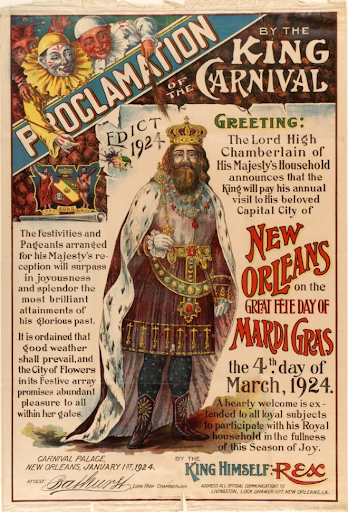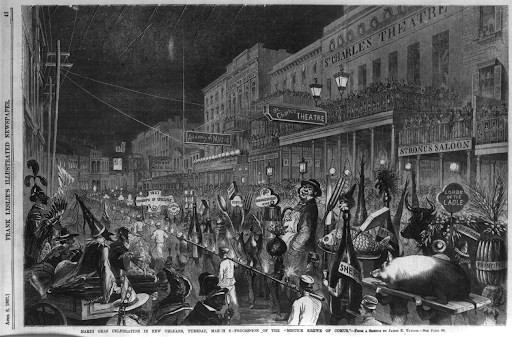Include a Topper!
-
Happy Birthday Banner
$9.00 -
Gingerbread Cake Topper
$15.00
Add Ons
Your cart is currently empty!
Since 1949 celebrating 75 years. Order online or call us at 1 800 GAMBINO (426-2466)

While Mardi Gras is known for its lavish parades and costumed revelry, there is also an air of romance and mystery which is sometimes overlooked. Though thousands gather to watch elaborate floats pass by, crying out for various trinkets, few give thought to the royalty waving at the crowds. Masked or bare-faced, the Royal Courts of each krewe are carefully chosen each year to represent the organization at various events including parades and Mardi Gras balls. Two of these courts, and their reigning monarchs, are among the most important tradition holders of New Orleans’ Carnival.

Since the 1800s, Rex and the Mistick Krewe of Comus, two of the oldest krewes, have each played large parts in shaping and maintaining modern Mardi Gras traditions. The Mistick Krewe of Comus, named after the Greek god of revelry, was formed in 1857 and put on the first organized Mardi Gras parade the same year. Their ornately decorated floats, themed costumes, and marching bands were so popular that thousands of visitors came to New Orleans the next year to witness the spectacle.

After parading down Canal Street, Comus held a masque ball where the party goers danced and drank until dawn. However, Comus and other members of the krewe left the ball at midnight to signify the end of Carnival and the beginning of the Lenten season. Comus stopped parading in the 1990s but still holds their ball every year on Mardi Gras night and every year, at midnight, the Royal Court of Comus continues to exit, leaving their guests to enjoy themselves.
Rex, Latin for King, formed in 1872 with the purpose of welcoming actual royalty to the Crescent City. Grand Duke Alexei Romanov, son of then Czar of Russia Alexander II, had been appointed as the goodwill ambassador to the United States and Japan and the Grand Duke’s visit to New Orleans coincided with Carnival season. To entertain him, a group of businessmen founded Rex, crowned a King of Carnival, and put on such a spectacle that the krewe was an instant hit. The song, If Ever I Cease to Love, became the krewe’s anthem in honor of the Grand Duke who had taken quite a liking to the song’s singer and even today If Ever I Cease to Love is heard every Carnival having been recorded by various artists over the years.
1882 saw the first “meeting of the courts” when the King of Carnival, Rex himself, paid a visit to the throne of Comus. Comus had issued an invitation to the Royal Court of Rex to attend Comus’ ball. By accepting, Rex showed respect for the elder krewe although whether this is because Rex is a king paying tribute to the god Comus or because Rex is acknowledging the importance and influence of the original Mardi Gras krewe is much debated. Still, this act ultimately showed a respect between the two krewes which would come to be quite important.
Since that first meeting in 1882, the meeting of Rex and Comus every year has evolved from a show of goodwill between organizations into the symbolic ending of Carnival. Just after 11pm, a red carpet is laid out and the Captain of Comus visits the Rex ball to invite the Royal Court to cross over to the Comus masque. As the Rex court enters into Comus’ ball, heralds announce their presence with a fanfare of trumpets and Comus and his Queen Consort greet the Rex court before they proceed in a double march about the room.

Ascending to their thrones, Comus and Rex gesture in unison to the crowd before both Royal Courts exit at midnight. The Captain of Comus brings down a curtain over the podium to show an end to Carnival and with that the formal Meeting of the Courts is done. (Although the courts will still be treated to a hearty breakfast in less formal surroundings.)
The magic of Mardi Gras is a combination of a great many things. The headiness of parade goers screaming in unison for a throw or two, dancing to marching bands and live music, creating and wearing a costume that allows you an extra bit of freedom to have fun, all of it has its place in creating the unreality that is Mardi Gras day. But among the madness an order is kept by the secret societies of the past. These krewes maintain a mystery and romance by upholding the traditions of Mardi Gras. And it’s these appointed officials, the Royal Courts, which helped begin New Orleans Carnival and which now help to end it every year.